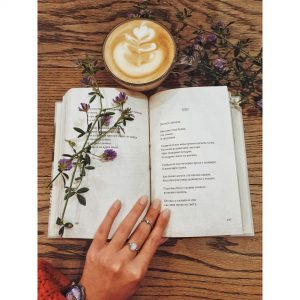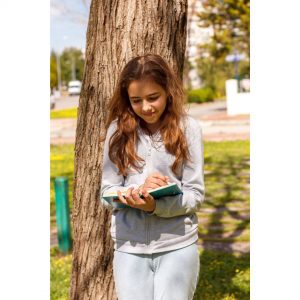As homeschoolers, we are all about DIYS! What better DIY than your own homeschool poetry unit study? The month of April is National Poetry Month, and it only seems fitting to put together a custom poetry unit to celebrate the love for poetry. Perhaps you have always been intrigued by poetry or maybe you are just now stepping into this world of rhythm and meter. Either way, helping your kids study poetry is a great supplement to their literature, and National Poetry Month is perfect timing! If you’ve been considering a study on poetry for kids, whether in elementary or even high school, we have some great resources for teaching homeschool poetry activities…and a FREE poetry study to download and use in your homeschool!
Where to Begin with Homeschool Poetry
Before sharing poems and learning about poets, let’s discuss how poetry should be read. Poetry requires a considerable amount of concentration and analysis. However, it’ll become easier with practice, and the reward will be great! Without knowing how to properly read a poem, readers can miss the layers of information, depth of meaning, and stirring emotions that are often packed into just a few lines. This website is a fantastic resource for learning how to read a poem; undeniably an essential foundation for a unit study on poetry!
Types of Poems and Styles of Poetry
Poetry is about far more than rhyming words and slinging together similar-sounding sentences. Poems are blanketed in deep meaning, with purpose carefully woven into each sentence. Meanwhile, poets must adhere to strict parameters in their writing. To get started with teaching homeschool poetry activities, let’s take a look at five popular types of poems:
- Haiku

A haiku is derived from Japanese roots with three non-rhyming lines. The haiku starts with a five-syllable line, followed by a seven-syllable, and ends with another five-syllable. While they most commonly discuss nature, haikus can be written about any subject and are very common for poetry on life.
- Ballad
Songs are often referred to as ballads, and for good reason! Ballad poems are often written to be sung and considering they are frequently love poems, they work well as beautiful songs. They usually contain refrains to be repeated (often known as the chorus in music), and they usually tell a story.
- Limerick
If you’ve heard limericks associated with children’s tales, that’s due to their whimsical nature. They are short, usually tell a story, and are meant to be humorous. Their five lines follow an AABBA rhythm. The popularity of limericks has extended beyond hundreds of years, made especially as famous poetry in the 1800s by a British poet named Edward Lear.
- Free Verse
Not all poems follow a rhyming pattern, and that’s especially notable in free verse poetry. Instead, free verse tends to employ other writing tools such as assonance and alliteration. Free verse is often seen as less restrictive by many poets. T.S. Eliot is a poet known for mastering the free verse style.
- Elegy
The elegy could possibly be considered the opposite of the limerick. Many poem styles are meant to be cheerful, but the elegy focuses on expressing sad emotions. Specifically, elegies have been popular through the years for lamenting the grief of loved ones. They tend to be most common at funerals, and can also be put to music.
While we have only covered a few, there are many more forms and types of poems to learn about. You can read more information about types of poetry for kids and love for poetry on these helpful websites!
Daily Homeschool Poetry Ideas
With Poem-A-Day, you can have a daily sample of famous poems emailed directly to your inbox! These are perfect for homeschool poetry time. These famous poems also include commentary and audio for further enjoyment and study. If you’d prefer to not sign up for emails, you can always follow them on social media as well!
Another homeschool poetry idea is using prompts. Many times, the most difficult part is getting started. Take the struggle away by choosing a different prompt each day! (Did you catch that rhyme? Ha!)
Hands-On Teaching Homeschool Poetry Activities
Even if you have a love for poetry, no one expects you to pick up a pen and write a poem off the top of your head. But, it’s fun to try! Additionally, here are a few homeschool poetry activities you and your kids could enjoy in celebration of National Poetry Month:
- Create a poetry-for-fun anthology.
- Write a letter to an award-winning poet.
- Memorize a poem.
- Try your hand at preparing a poet’s favorite meal or beverage.
- Join a poetry club, or start one!
- Read famous poems at an open mic.
- What’s an exquisite corpse poem? Try writing one with friends!
- Participate in Poem in Your Pocket Day on April 18! Choose a poem you enjoy, and carry it in your pocket all day to share with friends and family.
- Sign up for a poetry class or workshop.
Offer Support for Poets
- Purchase a poetry book from a local bookstore.
- Look for poetry for fun events in your city. Facebook is also a great place to search for events!
- Consider asking for a proclamation from your Mayor or state’s Governor in support of National Poetry Month.
- Attend a local poetry reading.
- Write a poem on a sidewalk! Share the creativity by grabbing some chalk and writing out the poem on a sidewalk for others to see and enjoy.
Watch Videos on Poetry
Poetry can seem dry and complex to someone just beginning to study it. Watching a few videos on poetry terms can help it come alive and feel more intriguing! This could be especially helpful for visual learners in addition to new poetry readers.
- Watch the movie, A Child’s Garden of Poetry.
- Watch (or read) Carolyn Forche’s talk on poetry.
- Still need some clarification on what constitutes a poem? This quick video, What Makes a Poem…a Poem? should clear that up.
Consider the Artistic Impact of Homeschool Poetry
It can be easy to discredit the importance of studying poetry when we don’t realize the impact it has on our world. Try these ideas to take a deeper look at how poetry and our culture coincide.
- Listen to “Why Poetry Matters Now.”
- Read these examples about how poetry matters within the U.S.
- Read at least the first chapter of “The Life of Poetry.”
- Through the mid-April month, you can order a National Poetry Month poster for FREE.




